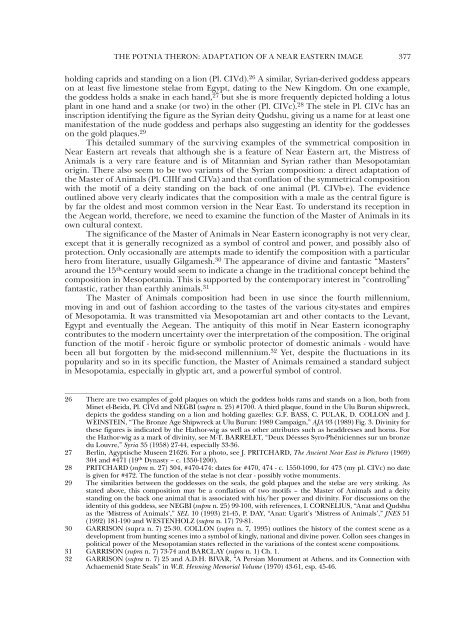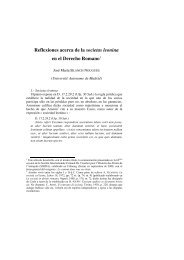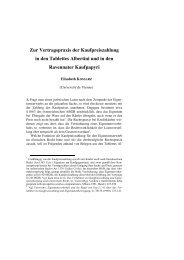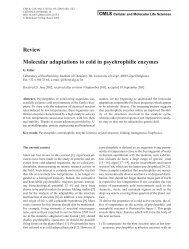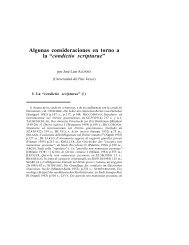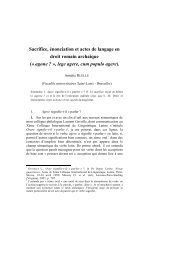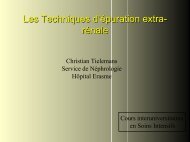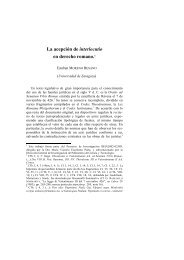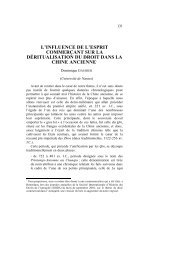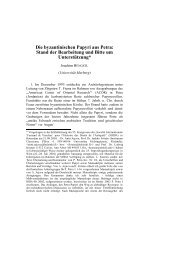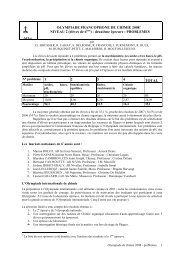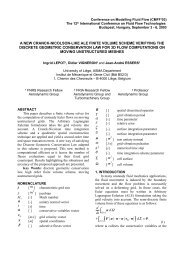The Potnia Theron
The Potnia Theron
The Potnia Theron
You also want an ePaper? Increase the reach of your titles
YUMPU automatically turns print PDFs into web optimized ePapers that Google loves.
THE POTNIA THERON: ADAPTATION OF A NEAR EASTERN IMAGE 377<br />
holding caprids and standing on a lion (Pl. CIVd). 26 A similar, Syrian-derived goddess appears<br />
on at least five limestone stelae from Egypt, dating to the New Kingdom. On one example,<br />
the goddess holds a snake in each hand, 27 but she is more frequently depicted holding a lotus<br />
plant in one hand and a snake (or two) in the other (Pl. CIVc). 28 <strong>The</strong> stele in Pl. CIVc has an<br />
inscription identifying the figure as the Syrian deity Qudshu, giving us a name for at least one<br />
manifestation of the nude goddess and perhaps also suggesting an identity for the goddesses<br />
on the gold plaques. 29<br />
This detailed summary of the surviving examples of the symmetrical composition in<br />
Near Eastern art reveals that although she is a feature of Near Eastern art, the Mistress of<br />
Animals is a very rare feature and is of Mitannian and Syrian rather than Mesopotamian<br />
origin. <strong>The</strong>re also seem to be two variants of the Syrian composition: a direct adaptation of<br />
the Master of Animals (Pl. CIIIf and CIVa) and that conflation of the symmetrical composition<br />
with the motif of a deity standing on the back of one animal (Pl. CIVb-e). <strong>The</strong> evidence<br />
outlined above very clearly indicates that the composition with a male as the central figure is<br />
by far the oldest and most common version in the Near East. To understand its reception in<br />
the Aegean world, therefore, we need to examine the function of the Master of Animals in its<br />
own cultural context.<br />
<strong>The</strong> significance of the Master of Animals in Near Eastern iconography is not very clear,<br />
except that it is generally recognized as a symbol of control and power, and possibly also of<br />
protection. Only occasionally are attempts made to identify the composition with a particular<br />
hero from literature, usually Gilgamesh. 30 <strong>The</strong> appearance of divine and fantastic “Masters”<br />
around the 15 th -century would seem to indicate a change in the traditional concept behind the<br />
composition in Mesopotamia. This is supported by the contemporary interest in “controlling”<br />
fantastic, rather than earthly animals. 31<br />
<strong>The</strong> Master of Animals composition had been in use since the fourth millennium,<br />
moving in and out of fashion according to the tastes of the various city-states and empires<br />
of Mesopotamia. It was transmitted via Mesopotamian art and other contacts to the Levant,<br />
Egypt and eventually the Aegean. <strong>The</strong> antiquity of this motif in Near Eastern iconography<br />
contributes to the modern uncertainty over the interpretation of the composition. <strong>The</strong> original<br />
function of the motif - heroic figure or symbolic protector of domestic animals - would have<br />
been all but forgotten by the mid-second millennium. 32 Yet, despite the fluctuations in its<br />
popularity and so in its specific function, the Master of Animals remained a standard subject<br />
in Mesopotamia, especially in glyptic art, and a powerful symbol of control.<br />
26 <strong>The</strong>re are two examples of gold plaques on which the goddess holds rams and stands on a lion, both from<br />
Minet el-Beida, Pl. CIVd and NEGBI (supra n. 25) #1700. A third plaque, found in the Ulu Burun shipwreck,<br />
depicts the goddess standing on a lion and holding gazelles: G.F. BASS, C. PULAK, D. COLLON and J.<br />
WEINSTEIN, “<strong>The</strong> Bronze Age Shipwreck at Ulu Burun: 1989 Campaign,” AJA 93 (1989) Fig. 3. Divinity for<br />
these figures is indicated by the Hathor-wig as well as other attributes such as headdresses and horns. For<br />
the Hathor-wig as a mark of divinity, see M-T. BARRELET, “Deux Déesses Syro-Phéniciennes sur un bronze<br />
du Louvre,” Syria 35 (1958) 27-44, especially 33-36.<br />
27 Berlin, Agyptische Museen 21626. For a photo, see J. PRITCHARD, <strong>The</strong> Ancient Near East in Pictures (1969)<br />
304 and #471 (19 th Dynasty – c. 1350-1200).<br />
28 PRITCHARD (supra n. 27) 304, #470-474: dates for #470, 474 - c. 1550-1090, for 473 (my pl. CIVc) no date<br />
is given for #472. <strong>The</strong> function of the stelae is not clear - possibly votive monuments.<br />
29 <strong>The</strong> similarities between the goddesses on the seals, the gold plaques and the stelae are very striking. As<br />
stated above, this composition may be a conflation of two motifs – the Master of Animals and a deity<br />
standing on the back one animal that is associated with his/her power and divinity. For discussions on the<br />
identity of this goddess, see NEGBI (supra n. 25) 99-100, with references, I. CORNELIUS, “Anat and Qudshu<br />
as the ‘Mistress of Animals’,” SEL 10 (1993) 21-45, P. DAY, “Anat: Ugarit’s ‘Mistress of Animals’,” JNES 51<br />
(1992) 181-190 and WESTENHOLZ (supra n. 17) 79-81.<br />
30 GARRISON (supra n. 7) 25-30. COLLON (supra n. 7, 1995) outlines the history of the contest scene as a<br />
development from hunting scenes into a symbol of kingly, national and divine power. Collon sees changes in<br />
political power of the Mesopotamian states reflected in the variations of the contest scene compositions.<br />
31 GARRISON (supra n. 7) 73-74 and BARCLAY (supra n. 1) Ch. 1.<br />
32 GARRISON (supra n. 7) 25 and A.D.H. BIVAR, “A Persian Monument at Athens, and its Connection with<br />
Achaemenid State Seals” in W.B. Henning Memorial Volume (1970) 43-61, esp. 45-46.


